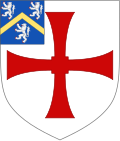| Ushaw: Historic House, Chapels & Gardens | |
|---|---|
| Formerly Ushaw College | |
 Main Building | |
| 54°47′17″N1°39′40″W / 54.78818°N 1.66116°W | |
| Location | Ushaw Moor, Durham |
| Country | England |
| Denomination | Roman Catholic |
| Website | www |
| History | |
| Former name(s) | English College, Douai |
| Status | Theological College |
| Founded | September 29, 1568 |
| Founder(s) | Bishop William Gibson |
| Dedication | Saint Cuthbert |
| Consecrated | September 1808 |
| Architecture | |
| Functional status | Closed as college, open as visitor attraction |
| Heritage designation | Grade II with parts Grade II* and St Michael's Chapel Grade I [1] |
| Designated | 17 January 1967 (main block and college chapel; other parts, including St Michael's Chapel, added 24 June 1987) |
| Architect(s) | James Taylor Dunn and Hansom |
| Style | Gothic Revival |
| Groundbreaking | 23 April 1804 |
| Completed | 2 August 1808 |
| Closed | June 2011 |
| Administration | |
| Province | Liverpool |
| Diocese | Hexham and Newcastle |
| Episcopal area | Sunderland and East Durham |
| Deanery | St Cuthbert |
| Parish | St Joseph's, Ushaw Moor |
 | |
Ushaw College (formally St Cuthbert's College, Ushaw) is a former Roman Catholic seminary, which until 2011 was also a licensed hall of residence of Durham University near the village of Ushaw Moor, County Durham, England, which is now a heritage and cultural tourist attraction. The college is known for its Georgian and Victorian Gothic architecture and listed nineteenth-century chapels. The college now hosts a programme of art exhibitions, music and theatre events, alongside tearooms and a café.
Contents
- History
- Founding
- University of Durham
- 21st Century
- Heraldry
- Alumni
- List of presidents
- References
- External links
It was founded in 1808 by scholars from the English College, Douai, who had fled France after the French Revolution. Ushaw College was affiliated with Durham University from 1968 and was the principal Roman Catholic seminary for the training of Catholic priests in the north of England.
In 2011, the seminary closed, due to the shortage of vocations. It reopened as a visitor attraction, marketed as Ushaw: Historic House, Chapels & Gardens in late 2014 and, as of 2023, receives over 100,000 visitors a year. The County Durham Music Service and Durham University Centre for Evaluation and Monitoring are based at the college and buildings at the college are also used by Durham University Business School. [2] [3]







